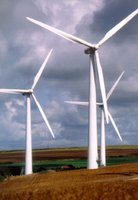Wind farm
| Topics: |
A wind farm (often also called a wind park) is as a cluster of wind turbines that acts and is connected to the power system as a single electricity producing power station.

Generally, it is expected that a wind farm consists of more than three wind turbines. Modern wind farms may have capacities in the order of hundreds of megawatts, and are installed offshore as well as on land. Modern wind farms generally are connected to the high voltage transmission system, in contrast to the early application of wind energy for electricity production with wind turbines individually connected to the low- to medium-voltage distribution system. Hence, modern wind farms are considered power plants with responsibilities for control, stability, and power balance. Thus, wind farms are required to contribute to the control of voltage, frequency and reactive power needs in the power system and stay on-line during less critical grid faults, and to help maintain the stability of the power system. While wind farm production cannot exceed the power given by the instantaneous wind resource, capabilities for regulating the power output at time scales consistent with the power system needs, powering up and down, are also included in order to assist with balancing and stabilizing the power system.
Limitations
Most of the other technical issues with wind farms are associated with the close spacing of multiple turbines. The close spacing implies that extraction of energy by wind turbines upwind will reduce the wind speed and increase the turbulence, which may cause reduced efficiency and higher loads on downwind turbines. Another technical issue for large wind farms is the electric grid connection and the integration into the power system. Large wind farms are very visible, especially at land and in coastal areas and this together with a number of environmental concerns, such as killing of migrating birds and bats, play an important role in the wind farm planning process and can result in selection of sites with less than optimal wind conditions. However, good wind conditions are essential for the economics viability of any wind project, and methods for accurately predicting wind climates at specific sites worldwide is constantly being improved.
Bird mortality
Wind turbine bird mortality is a by-product of large-scale wind farms, which are increasingly promoted as an alternative to fossil fuel derived energy production. To adequately assess the extent of impact to avian populations, deeper factors than gross mortality by turbine action must be assessed. In particular, one must examine: (a) impacts to threatened bird species, (b) total impacts due to avian habitat loss as well as direct mechanical kill, (c) ecological impacts due to apex predator bird loss and (d) future siting decisions for windfarms, since much of the prior bird mortality is due to poor siting decisions.
Bird mortality from wind turbines is a significant adverse ecological impact, and threatens to expand in scope dramatically with the rush to develop new energy sources. This impact is measured as high due to the loss of threatened species and due to disproportionate mortality of top level predators, whose decline can unravel the integrity of entire regional ecosystems. The rapid development of numerous large scale wSind farms may be a repeat of the ecological disasters of the 1970s, as the world rushed to produce hydropower from every possible river; decades later, we now realize the folly of that hydroelectric excess.
Over four million direct kill bird deaths per annum by 2030 are projected in some scenarios of wind turbine installation. The sheer volume of bird kill does not begin to depict the magnitude of ecological damage, since the most susceptible species tend to be those which are keystone species or species already threatened by other human pressures. Additionally, bird mortality due to large wind farms is exacerbated by inherent linkages between bird behavior and windfarm siting decisions. Proponents of large scale wind farms (including some federal agencies), for example, tend to favor sparsely vegetated saddles or other funnel like landforms, which are highly correlated with high density bird migration routes or raptor soaring locations.
See Also
References
- Erik Lundtang Petersen and Peter Hauge Madsen. 2004. Wind farms. In, Cutler J. Cleveland, Editor, The Encyclopedia of Energy, vol 6., pp. 449-463.
- American Bird Conservancy. 2011. Bird Deaths from Wind Farms to Continue Under New Federal Voluntary Indu72-81stry GuidelinesLuis Barrios and Alejandro Rodriguez. 2004.
- Behavioural and environmental correlates of soaring bird mortality at on-shore wind turbines. Journal of Applied Ecology, 41: 72-81